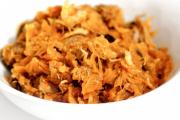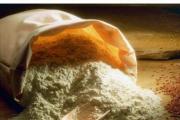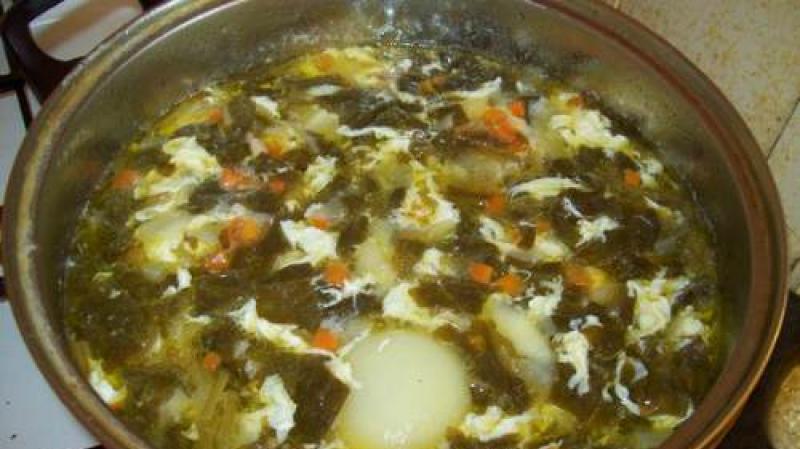Do I need to rinse rice for sushi. Rice for sushi and rolls. We take everything we need and start cooking.
original recipe. Rice is the basis of sushi and rolls. Not only the appearance, but also the taste of the final product will depend on how you cook it. It is no secret that a special kind of rice with short grains is used to make sushi. Now it is not a problem to buy such rice, it is sold in large hypermarkets and specialized stores. To make delicious rice, you need to properly season it with vinegar. How to make it at home, read my recipe.
Ingredients for Rice for Sushi and Rolls:
- (You will need special rice for sushi with short grains. Sold in specialized stores and large hypermarkets) - 1 kg
- (Need rice vinegar for Japanese cuisine. Sold in specialized stores and hypermarkets) - 250 ml
- (Regular or marine, optional) - 90 g
- (Regular granulated sugar) - 210 g
Cooking time: 60 minutes
Nutritional and energy value:
Recipe "Rice for sushi and rolls":

You will need rice for sushi. I took the most ordinary rice for sushi, which is sold in the hypermarket. In fact, rice in a pack, as in the photo, of the Agro-Alliance brand is better in quality than some varieties of rice that are sold in specialized stores. It does not contain rice husk stones and other debris.

Rice needs to be washed with cold water about 5-6 times, possibly more - depending on the quality of the rice, the presence of foreign debris, etc. I washed 1 kg of rice. One kilogram of rice produces 2 kilograms of boiled rice. If you don't need that much, take a smaller amount of rice.

After you have washed the rice, you need to transfer it to a flat-bottomed pot or a bowl of a rice cooker (multi-cooker). Then it all depends on what you will cook the rice in: if in a saucepan, then you need a ratio of 1: 1.5, for 1 kg of rice 1.5 liters of water; if in a rice cooker or slow cooker, then the ratio of rice to water is 1 to 1. Before pouring rice with water, spread it on the bottom in an even layer and press it well.

We cook rice. The first method is in a rice cooker or slow cooker. Everything is simple here: we set the program, cook for 20-25 minutes, after which we leave the rice on the heating for about 20-30 minutes, or longer. Second: cook in a saucepan, it's a little more complicated. Pour 1 kg of rice into a pan with a flat bottom (important) and add 1.5 liters of water. Bring to a boil. Reduce heat to medium and cook for 20-25 minutes. until ready. Then turn it off and let the rice stand for another 10-15 minutes.

Next we need rice vinegar. You can use vinegar from any manufacturer that you like or have available. In no case should rice vinegar be replaced with another, for example, apple or grape. We need 250 ml of rice vinegar, from which we will cook the sauce for dressing the finished rice.

We need sugar to make the sauce. The most common granulated sugar in the amount of 210 gr. I do not recommend using cane sugar or brown, although you can try.

We need salt to make rice dressing. Here there is a choice: you can use ordinary rock salt, iodized or sea salt. Everything depends on your desire. I use the most common rock salt. We need 90 gr.

While the rice is cooking, you can cook the sauce for its dressing. To do this, pour 250 ml of rice vinegar into a suitable container and heat it over low heat to a temperature of 80-90 degrees Celsius, in no case do we boil it.
Cooking rolls or sushi is an exciting activity for lovers Asian cuisine. You can learn how to cook rice for sushi from culinary magazines and other resources, but the process has some peculiarities, without which the dish will not turn out tasty and of high quality.
Without products such as rice vinegar and special seaweed, it is impossible to make rolls, so be sure to find these ingredients before preparing the base. It is also important to cook the cereal correctly, the type of Japanese dish depends on it.
Classic recipe
Sushi rice should be prepared so that it is not too soft, but at the same time, it is more difficult to make a dish out of a hard product. At the initial stage, you will need the following components:
- rice (1 cup);
- nori seaweed (1 plate);
- good quality water (500 ml).

Cooking process:
- Pour the washed cereal with water and leave for 30 minutes.
- Put the nori seaweed in the pan and put the food container on the fire.
- When the liquid boils, remove the seaweed from the rice and reduce the heat to a minimum, and boil the rice grits for another 10 minutes.
- Turn off the burner and cover the pan with a lid so that the cereal is steamed for 20 minutes.
In a slow cooker
At home, people often use this device to facilitate the cooking process. Stock up on the following ingredients:
- rice (200 gr.);
- boiled water (1 glass).

Cooking process:
- Put the washed rice grains into a multicooker bowl and fill with water.
- Close the lid of the multicooker and select the mode for cooking pastries or cereals, set it for 10 minutes.
- Upon completion of the process, reset the equipment to the extinguishing program, indicating the time - 20 minutes.

Advice! If you are preparing a product from a Japanese manufacturer, designed specifically for rolls, do not forget to soak it. Other varieties of cereal can be put into the unit without pre-soaking.
Vinegar dressing recipe
Aromatic liquid is designed to sprinkle 500 g of rice and give it a characteristic smell characteristic of Japanese cuisine. To prepare it, take the following ingredients:
- rice vinegar (2 large spoons);
- granulated sugar (1 small spoon);
- salt (1 small spoon).
Cooking process:
- Combine all ingredients in a small saucepan and place over low heat.
- Stir the mixture, achieving complete dissolution of the products, for 15 minutes and remove the finished rice dressing from the stove.
Making Rice Vinegar as a Dressing
If you have a lot of free time, it will not be difficult to make this product. Stock up on the following ingredients:
- white rice (1 cup);
- granulated sugar (1 large spoon);
- yeast (5 gr.);
- egg white (1 pc.).
Cooking process:
- Soak the washed rice in cold water, using 4 cups of liquid, and put the pan with the product in the refrigerator overnight.
- In the morning, drain most of the water without rice into a glass container, and place the rest (1 glass) in a separate bowl and dissolve the sugar in the liquid.
- Next, put the rest of the liquid on the fire and wait until the syrup becomes warm.
- Now turn off the burner and add high quality yeast to the heated syrup and leave the mixture to ferment for 3 hours.
- Pour the starter into the main pot of rice water and put the container in a warm place for the further fermentation process, it averages 4 days. During this period, foam will form from air bubbles.
- At the end of the process, pour the liquid into a clean glass container and close tightly, in this form it should remain at room temperature, infused for 30 days.
- After the specified period, strain the vinegar through cheesecloth and pour it into a new pan, add raw egg white and boil the product.
- Ready rice vinegar is cooled and filtered again, after which it is bottled in dark glass.

seaweed rice dressing recipe
If you have about 1 kg of sushi rice, prepare a dressing that has a special flavor. For this purpose, you will need the following products:
- rice vinegar (70 ml);
- granulated sugar (1 tablespoon);
- salt (1 teaspoon);
- dried nori seaweed (1 plate).
Cooking process:
- Combine all the ingredients in a common saucepan and put it on fire, heat the marinade until the salt and sugar dissolve, but do not bring the mixture to a boil.
- After removing the liquid from the stove, remove the seaweed and be sure to use hot vinegar.
Preparing Soy Sauce Dressing
It is easier to make such a mixture than the usual dressing for rice cereals. Prepare the following ingredients ahead of time:
- soy sauce(1 tablespoon);
- boiling water (3 tablespoons);
- salt to taste.
Cooking process:
- Mix all the products in a saucepan, paying special attention to salt - it should not be much, as soy sauce has a spicy taste.
- Now heat the ingredients over low heat, without bringing them to a boil.
- Let the mixture cool and stir again, then use to soak the rice.

How to choose the right rice for making sushi or rolls
Japanese cuisine is based on the opinion that food should not only satisfy a person's hunger, but also bring him aesthetic pleasure, so rice for sushi must be chosen correctly. In large supermarkets, you can find special varieties of sticky and sticky cereal, from which this national dish is easily folded.
But if the nearest store does not have the right product, it is allowed to use ordinary round-shaped rice for making rolls.

Pay attention to the fact that excellent quality cereals have an aesthetic appearance, the grains are white and round. But brown, golden and varieties with long grains are not suitable for making sushi, so they should be excluded from the list. necessary ingredients. The high gluten content makes rice the best choice, as the rolls should perfectly hold their shape and not crumble in your hands.
The manufacturer must inspire confidence, it is best to purchase a product from Asian firms, but Krasnodar rice is also of high quality.
It is important to know that rice in bags intended for boiling is not suitable for making sushi. Do not forget to thoroughly rinse the rice in clean water, there should be no black particles and impurities in it.
Why do you need refueling
Everyone who is interested in Japanese cuisine can learn how to cook rice for sushi, but the correct dressing plays an important role in the process of creating rolls. It gives the dish a unique taste, increases the stickiness of the cereal, so without this component it is impossible to imagine the real creations of Japanese chefs.

When cooking rice groats, salt, according to the recipe, is not added, and a good dressing gives the dish all the necessary spices. Rice vinegar is considered an important ingredient for sushi in Japan, but is not always found in other countries.
Some people try to replace the special rice vinegar with the usual apple or wine vinegar, but they are not always able to keep the proportions right and get a good quality dressing. It is much better to try making Japanese vinegar at home using the recipe above.
Advice! Store any dressing in the refrigerator to keep it fresh and tasty, but the mixture will need to be warmed up before use.
How to choose seaweed and soy sauce
No culinary specializing in Japanese cuisine can do without dried and pressed seaweed. There are several varieties of this product, and it is sold in the form of large sheets or plates, each package contains from 10 to 100 pieces.

Advice! Give preference to dark-colored nori seaweed, as their aroma will be bright and memorable.
Like nori seaweed, soy sauce is used by cooks to add ready meal characteristic aroma. This product does not contain artificial additives - preservatives and dyes, as it is prepared by natural fermentation. It is recommended to choose a sauce in a glass container, as it retains the benefits and taste of the sauce.
Many Japanese dishes and snacks include rice cooked using a special technology. If you do not know the peculiarities of its preparation, sushi and rolls may not turn out to be as tasty as they should be. But knowing how to cook rice for rolls, you don’t have to worry that the dish will fail.
One of the main tasks is to choose the right rice. In large supermarkets, packs with the name "Sushi Rice" are sold, which you can safely buy. But it is permissible to use ordinary round-grain cereals. If everything is done correctly, then there is not much difference between it and the Japanese variety. The main thing is not to buy a long-grain variety - it is completely unsuitable for these dishes.
Rice for rolls must be round, large, firm, not steamed.
The main characteristic of such grains is their high gluten content, which allows the finished rice to be quite sticky and dense. The finished mass should be sticky enough so that it keeps its shape well, but not so much that it sticks to the teeth while eating.
How and how much to cook rice for rolls
Cooking rice properly is not as difficult as it seems at first glance.



Basic cooking rules:
- Before cooking, the cereal must be sorted out to avoid surprises while eating in the form of small pebbles and black pieces of unrefined cereals.
- Then you should thoroughly rinse the cereal with cold water several times. At the same time, Europeans believe that 3-4 times is enough, but the Japanese say that the more rice is washed, the tastier it is. Therefore, Japanese chefs wash the grits at least 7 times. The drained liquid must be completely transparent and clean. When washing, the Japanese monitor whether all the grains sink to the bottom. Those specimens that float to the surface are considered unusable and are simply thrown away.
- Sometimes it is recommended to fill the grains with water for the last time and leave for 40 - 50 minutes, and then rinse again and pour in a ratio of 1 to 1.25.
- For cooking, you can use a regular saucepan with a thick bottom or a cast-iron cauldron. The contents of the container are brought to a boil, then the heat is reduced, covered with a lid and boiled for about ¼ hour.
- There is no need to stir or lift the lid. When steam comes out, the taste properties are lost. The cereal should be completely at rest, so you can’t mix it with a spoon, touch it, checking readiness. Knowing how much to cook rice, you should not try to boil it longer than the specified time, as the grains will be overcooked and stick to the bottom of the pan. Of course, from the first time it is difficult to guess how the rice will behave, in addition, it also depends on the performance characteristics of the stove. But over time, experience and knowledge come, how to cook rice so that it is tasty and reaches the desired condition.
- Leaving the container from the fire, leave it for 12 - 14 minutes. The remaining water and steam should be absorbed into the rice grains. Only after that, the cereal can be transferred to another bowl and seasoned. It is impossible to intensively mix the mass after adding the dressing, otherwise it will turn into an unattractive viscous porridge. Moreover, if the rice is cooked correctly, it will not stick to the pan.
In general, the cooking time for rice rolls does not exceed 35 minutes. To make the rolls brighter and more elegant, you can add natural dyes to it. Plum vinegar gives the mass a pleasant raspberry hue, turmeric - orange-yellow, and crushed seaweed - soft grassy.
Cooking in the traditional way in a saucepan

Ingredients:
- Japanese rice - 1 tbsp.;
- rice vinegar - ¼ tbsp.;
- water - 250 ml;
- sugar and salt - 0.5 tsp each.
Cooking:
- Rinse the cereal well at least 6 times.
- Pour it into a saucepan and cover with water. Do not add any spices or salt.
- Bring to a boil, close the lid and reduce the heat. Cook for 12-15 minutes until the liquid has evaporated.
- Prepare the dressing: Pour sugar and salt into the vinegar and heat on the stove, stirring to dissolve the ingredients. You can simply put the container with dressing in the microwave and heat to the desired temperature.
- Leave the finished mass for 12 minutes so that it steams well, and only then transfer it to another plate, pour in the dressing and mix.
When the mass has cooled, it can be used to make rolls. You can’t leave rice the next day - the grains will become hard and tasteless, lose moisture.
If the mass still needs to be saved for future use, you can do this: divide it into several small parts and decompose it into plastic bags. If you put the whole mass in the bag, its inner part will be oversaturated with moisture, and the upper part will dry out. You need to keep such blanks in a cool place, but not in the refrigerator - the temperature is too low there. But even in this form, rice can be stored for no more than 48 hours.
Recipe for making rice for rolls in a slow cooker
The slow cooker does a great job of cooking rice for sushi and rolls. For this, the "Rice" or "Buckwheat" modes are used.



Required products:
- rice - 2 tbsp.;
- water - 2.5 tbsp.
The cooking process almost does not require human intervention:
- The sorted and washed rice should be transferred to the multicooker bowl and poured with water.
- Set the Rice mode. If it is not there, which is already very rare, you can turn on the "Buckwheat" mode. Alternatively, you can use a combination of the "Baking" (10 minutes) and "Stew" (20 minutes) modes. Do not open the lid during cooking.
The finished cereal will only have to be transferred to a separate bowl and seasoned.
Aromatic rice cooked with nori
Nori seaweed gives a special aroma and unique taste. To cook in this way, it is enough to put a small piece of pressed nori into the water before boiling, and then remove them after boiling, otherwise they will spoil the taste of the cereal.

For 200 g of rice you need to take:
- 250 ml of water;
- some algae.
Cooking:
- Pour the sorted and washed cereals with cold water. Add nori.
- Boil the water, remove the seaweed, reduce the heat to a minimum and close the lid.
- Cook no more than a quarter of an hour.
After switching off, do not lift the lid for ¼ hour. At this time, it is convenient to prepare the dressing and then combine it with the cereal.
How to make with apple cider vinegar
You can also cook rice with apple cider vinegar. The number of components indicated below is indicated for 500 g of cereal:
- apple cider vinegar - 75 ml;
- ordinary vinegar - 15 ml;
- sugar - 60 g;
- salt - 35 g.
Combine all the ingredients and melt on the stove until the salt and sugar dissolve. Instead of apple cider vinegar, you can use grape vinegar or lemon juice. Dressing is added along with water at the very beginning of cooking.
Required Ingredients:
- rice vinegar - 180 ml;
- salt - 1 tbsp. l. with a slide;
- sugar - 6 tbsp. l.;
- dry Kombu seaweed - 3 g.
Instead of ordinary table salt, you can take sea salt, this will give the rice a real Japanese flavor. All ingredients should be mixed, warmed up a little, but do not boil. To make the bulk ingredients dissolve faster, the solution can be stirred with a spoon. Algae is enough to put in the dressing for 10 minutes, and then remove.
Let the dressing cool slightly and add to the still warm rice. The exact ratio of ingredients can be adjusted to your liking.
Dressing, unlike rice, can be prepared ahead of time. Just keep it tightly sealed. glassware so that it does not absorb foreign odors.
Rolls and sushi are made from slightly cooled rice, but in no case are cereals allowed to cool by themselves. In Japan, a fan is used for rapid cooling, as it is believed that the grains cooled in a short time acquire a special shine.
Knowing the intricacies of cooking rice using Japanese technology, you can safely surprise your loved ones and friends with delicious national dishes of the country of the Rising Sun.
- one of the most popular and beloved cereals, which has found application in many cuisines of the world. Rice is especially revered by the Japanese, because it forms the basis for the preparation of the most famous national dishes such as sushi and rolls, so choosing the right variety is of great importance.
Of course, the easiest way to choose rice suitable for rolls is to buy Japanese, which is often sold in large supermarkets. But if you know the basic requirements for cereals for the preparation of these "rolls", then it is quite possible to choose rice from other commercially available varieties.
Which variety to choose?
There are many varieties of this crop, each of which has certain properties, but not all of them are suitable for making rolls. The main requirement for rice in this dish is that it be sticky enough, but not turn into porridge when cooked. Round-grain varieties are considered the best for rolls. They make a good alternative to traditional Japanese cereal. Round-grain rice absorbs a large amount of liquid when cooked, and also contains a lot, which makes it matte. During the cooking process, such rice becomes soft and sticky, which means it meets the necessary requirements. Of the domestic varieties with similar properties, it is possible to single out Krasnodar round rice, the properties of which are identical to the Japanese varieties Nishiki and Kahomai. In Primorsky Krai, an elite rice variety called "Fushigon" is grown, it also has high stickiness, and its snow-white, even and smooth grains are rich in vitamins and minerals. This variety is perfect for making rolls.
What to pay attention to?
The quality of the cereal used depends on how tasty, beautiful and nutritious the dish will come out. When buying rice, pay attention to the integrity of the grains and their color. Steamed rice should not be used, it is easily distinguished by its characteristic creamy hue. After cooking, such cereals become crumbly, it is almost impossible to form rolls from it. The freshness of the cereal used is also one of the most important factors in cooking. If the cereal has been stored for several years, you risk spoiling the rolls using it.
Preparing cereals for cooking
There are many options for preparing rice for rolls, but the preliminary preparation is always the same. First of all, you need to make sure that the cereal is clean and, if necessary, sort it out. Then rinse thoroughly, changing the water several times.

Cooking methods
Each cook, as well as many lovers and admirers of oriental cuisine, will surely have their own signature recipe for making rice for rolls. We will present only some of them.
Method 1
Pour the prepared cereal with water and leave to swell for about 30 minutes, then add water, bring to a boil and, reducing the heat to a minimum, simmer for another 20 minutes.
Method 2
Pour rice with cold water to swell. After about an hour, add water at the rate of 250 ml per 200 grams of rice and cook in a cast iron pan over medium heat for about 15 minutes. After that, remove from the stove and, without opening the lid, give the grits the opportunity to reach a state of softness.
Method 3
This is the alternative way. Surely, many housewives, having a rice cooker in their kitchen arsenal, will use it to cook rice.
Sometimes it becomes necessary to cook rice in advance. In this case, you need to store it in ceramic or glassware, avoiding sunlight and moisture.
Rice dressing
Perhaps the most important thing in cooking rice for rolls is its dressing. It is she who gives a piquant unique taste to real Japanese rolls. You can prepare the original dressing yourself. To do this, you will need to mix 2.5 tablespoons of rice vinegar, 2 tablespoons and 1.5 teaspoons. Then, stirring constantly, heat on the stove until the sugar is completely dissolved and season with warm rice.
bright strokes
Quite often cooked with dyed multi-colored rice. To obtain bright and saturated colors, only natural dyes are used, for example,. Thanks to it, the rice acquires a bright yellow color. Addendum plum vinegar color the rice pink. Rice becomes green when cooked with seaweed.
Calling sushi fast food is not a good idea. After all, rolling rolls is a real art, which is diligently learned from the masters. Yes, and eating sushi among the Japanese turns into a complex and lengthy ceremony. And although the ingredients for rolls and sashimi are, in general, simple products(rice, fish, seafood, soy sauce), these dishes are quite difficult to prepare. But you can, even at home. In this article, we will not talk about how to spin rolls. We will focus on only one stage of their production - we will discuss how to make rice for sushi at home. This is the base of the dish. If you compare rolls with fine art, rice is the primer for the painting, on which the artist must apply paint. Yes, of course, the taste of sushi is determined by fish or seafood. But if the rice in them looks like porridge from kindergarten, all the art of creating this dish will come to naught.
Japanese Vinegar and Nori: Cooking Your Own Rolls
For sushi, special devices are needed - at least makisu, for professional folding of products. Exotic products will also be required. For example, nori is sheets of dried and pressed edible seaweed. Or wasabi - a special horseradish paste. Gari - thin layers of pickled ginger - is also difficult to cook at home. But Japanese vinegar can be created independently. To do this, dissolve two large spoons of sugar and one teaspoon of salt in a third of a cup of ordinary table (or apple) acidifier. We don't need much Japanese vinegar. For two cups of rice, only two spoons. But it defines the basis of taste. Now let's start cooking rice for sushi at home. The recipes in this case advise us not to be amateur, but to strictly adhere to the Japanese tradition. After all, it has been practiced for centuries.

What kind of rice is suitable for sushi
As for cereals, it requires a special one. Small and round grains containing a lot of gluten. In large supermarkets in special departments, a special “Sushi Rice” is sold. At home, recipes suggest taking Krasnodar or Crimean cereals. In appearance, it resembles Japanese. Elite basmati is good for pilaf, but not for rolls. Sushi rolled from it will crumble. Also, you don’t need to be smart and show imagination where this is not required: all sorts of steamed, brown, unpolished and wild varieties will not work. Also masters Japanese cuisine rejected rice in pouches. Only round grits, polished and not crushed, will do. If there is none, long-grain rice should be poured with cold, preferably filtered water for a couple of hours. Then rinse and put to boil.
Food Replacement Secrets: How to Turn Krasnodar Rice into Japanese Rice
Groats, ripened in the water-filled fields of the Land of the Rising Sun, are not only small and round, but also contain a large amount of gluten. It is thanks to her that the rolls keep their shape well. How to use for sushi at home? Recipes suggest that we thoroughly rinse the cereal. Pour two glasses into a sieve or a shallow colander and keep under running water until clean and clear water flows from the cereal. Thus, we will get rid of the excess. In no case should porridge for sushi be crumbly. But an overly viscous and watery base will also not work. Therefore, the ratio of water and cereals when cooking porridge is the second very important condition creating successful rolls.

How to cook rice for sushi at home
The recipe suggests that we fill the cereal with cold water. But if for pilaf or porridge we keep the proportions one to two, then the rolls require a different approach. Rice and water should be equal. For two glasses of cereal, the same amount of liquid should go. “How will porridge be cooked, you ask, will it not burn?” The whole secret is how to cook rice for sushi at home. Recipes for creating pilaf, casseroles, grandmothers, baby cereals and rolls are very different. Rice is a versatile cereal. From it you can make a hard, like a loaf, a bun, and a pudding, and a viscous mixture. So, pour the washed rice with cold water and put it on the stove. It is best to take a saucepan with a thick bottom and not enameled. The ideal solution would be a small cauldron for pilaf. After the contents of the saucepan boil, cover it with a lid and cook for one minute over high heat. The time limit must be taken seriously - 60 seconds, no more and no less. Then the fire should be reduced. We do not remove the lid and cook the porridge for about fifteen to twenty minutes. As soon as we see that the liquid has completely evaporated, turn off the heat under the saucepan. Let stand covered for another ten minutes. So we get in measure for sushi.

Recipe at home in a slow cooker
Many doubt: can a machine make cereal for rolls? After all, Japanese chefs put their soul into every stage of preparing this incomparable dish. Let's put aside any doubts. The slow cooker not only copes with this task, but creates just the perfect rice for sushi. Cooking at home in a slow cooker will not take you much time. And the result will be even better than if you cooked cereals in a saucepan. After all, you do not need to open the lid, which means that you will not release steam from the container, which is why the rice will reach perfect stickiness. The only thing you should take care of is to rinse the cereal well. You need to pour a little more water - 2.5 measures of liquid for two glasses of grain. The multicooker bowl should be filled no more than two-thirds of the volume. Set the mode to "buckwheat" or "rice". In machines of a different design, you can use the Baking program by setting the timer for ten minutes, and when the time runs out, start the Stew for twenty minutes.

Authentic Sauce
Even properly cooked cereals will remain simple porridge if sauce is not added to it. Authentic Japanese sushi dressing includes cooking wine mirin (or sake vodka), special rice vinegar, sea salt and sugar. It gives a special charm to the base for rolls. It is put into the sauce when it warms up, and then pulled out. Dressing and rice when combined should be approximately the same temperature - warm. Believe me, but real masters cool the grits with a fan so that it shines beautifully in rolls. But on the agenda we have rice for sushi at home. Recipes, photos and helpful tips teach us how to do without exotic ingredients and get a product that is as close to authentic as possible. So, let's prepare the sauce based on 250 grams of cereal.

What is rice vinegar
Although it is called Japanese, it was invented by the Chinese. According to some reports, this happened more than two thousand years ago. How was this vinegar prepared? The fish was cut into small pieces. Then it was salted and mixed with rice. The enzymes secreted by the fish acted on the groats, and lactic acid was released. She, on the one hand, preserved the fish, increased its shelf life up to a year, and on the other hand, gave it a sour taste. In the fourth century AD, rice vinegar became known in Japan. It was very expensive and only nobles used it. For the common people, vinegar became available only from the sixteenth century. Why do we provide all these details? To show that, compared to other European sauces, rice sauce has the mildest taste. In addition, it is an excellent antibacterial agent. And if we take into account that in Japan it is often served at the table raw fish, to protect yourself from various infections is very important. And most importantly, the sauce ennobles the sushi rice. The recipe (following it at home is not a problem), which we will give below, assumes the presence of this vinegar. Getting it, when the popularity of rolls around the world is growing, is not so difficult. It is sold in the same stores as wasabi and nori seaweed.

Sauce with vinegar
Well, let's season our sushi rice. The recipe at home is not much different from the one used in professional Japanese restaurants. The main thing is to have Mitsukan rice vinegar. It will require 180 milliliters. In this vinegar, dissolve 120 grams of sugar and a spoon sea salt. It is also worth putting a small piece of kombu seaweed at the initial stage. After ten minutes, it can be thrown away. We heat all the ingredients, but do not bring to a boil. Then we cool, pour into a glass, tightly closed dish and put it in the refrigerator. That is, the sauce can be prepared for the future. But if you want to use a small amount for already cooked rice, cool the sauce to the temperature of the cereal. Pour in a small amount of mirin or sake. If there is no Japanese alcohol at hand, it’s okay, we’ll skip this cooking step. Arrange the rice in a wide bowl. Drizzle with sauce. With a wooden spatula, carefully turn the rice over, but do not interfere with it (otherwise you will get porridge). Cool down to room temperature. Everything, you can twist the rolls.
rice vinegar alternative
All European types of acidifiers have a more pronounced taste, so they need to be added in small quantities. There are several ways to make a dressing to pour over sushi rice. Recipe (at home) with apple cider vinegar- one of them. Mix a tablespoon of acidifier with a teaspoon of sugar and a pinch of iodized salt. Pour one and a half tablespoons of hot water into this solution. Stir until the crystals completely disappear. Pour rice with this sauce.













